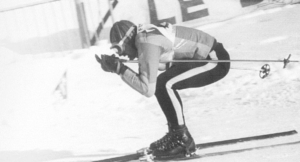Editor Note: This is the first of a two-part article by www.SeniorsSkiing.com where ski industry veteran Val E. discusses whether using old equipment is safe and/or worth it.
We’ve all seen people in the lift line with really old equipment; ours is not to reason why. However, if you are a skier who is clinging to their aging equipment, you should know what the risks are.

Here are some things to consider regarding old equipment.
Skis
Imagine you have 20-plus year-old skis, you use them 7-10 days a year, so the total work days would be 200-300 days. Can you still use them? If they have no major delamination, cracked edges, broken sidewalls, then yes.
Do you want to use them? Maybe not. Test a few pairs of skis made in recent years. You may notice that they are easier to maneuver, easier to carry, and have different graphics. If you still want to continue skiing on your old skis, then sharpen the edges, clean and wax the base, and make sure the bindings are safe.
Bindings
Bindings are for safety and comfort. Manufacturers do not allow ski service people to service bindings older than 10 years, and they send a list of “serviceable” models every fall.
Bindings stored 360 days a year in a dusty room or wet garage may not release when you need it or can false release. Dust on lubrication, corrosion, and other factors may change the planned schedule.
Major problems could be cracks in plastic parts that are hard to identify. A binding can still be OK for many, many years. Manufacturers just don’t want to be responsible for risk anymore, and they also want us to buy new and better bindings.
You can install new binding on your old skis (if you love them unconditionally). A technician can plug the old holes.
Boots
Most people don’t like to change ski boots often, though there is always a limit. We are talking about boots that are 15-20-plus years old.
Shell: If you see cracks in plastic, your soles are worn out and won’t have good contact with the binding. If buckles are broken and nonrepairable, go to a ski shop.
Liner: You should feel comfortable without two pairs of thick homemade wool socks, your heel shouldn’t ever move up from the insole. If your shell is in a good shape, but you are not happy about the liner (too loose or destroyed) keep in mind that you can purchase a pair of liners. Canadian company Intuition Liners makes different types.
Helmets
Almost all ski helmets use foam (Polystyrene or Polypropylene) in their construction to crush, thus absorbing energy when contacting something hard. Researchers say this foam doesn’t change much for 20-30 years under normal conditions. But hard hits, long exposure to UV and heat sources may change the properties of these materials.
Manufacturers recommend replacing a helmet after a significant collision. Once foam is compressed at some spot, it will not protect you anymore.
Author Val E. has an interesting background in the ski industry. He has worked as a ski slalom course supervisor, snowboard technician, ski/snowboard clothing consultant, ski engineer, ski/snowboard writer and photographer in the U.S. and in Europe. He has traveled to 25 countries, found snow in 11 of them, and is still searching. Val currently lives in the Washington DC Metropolitan Area.